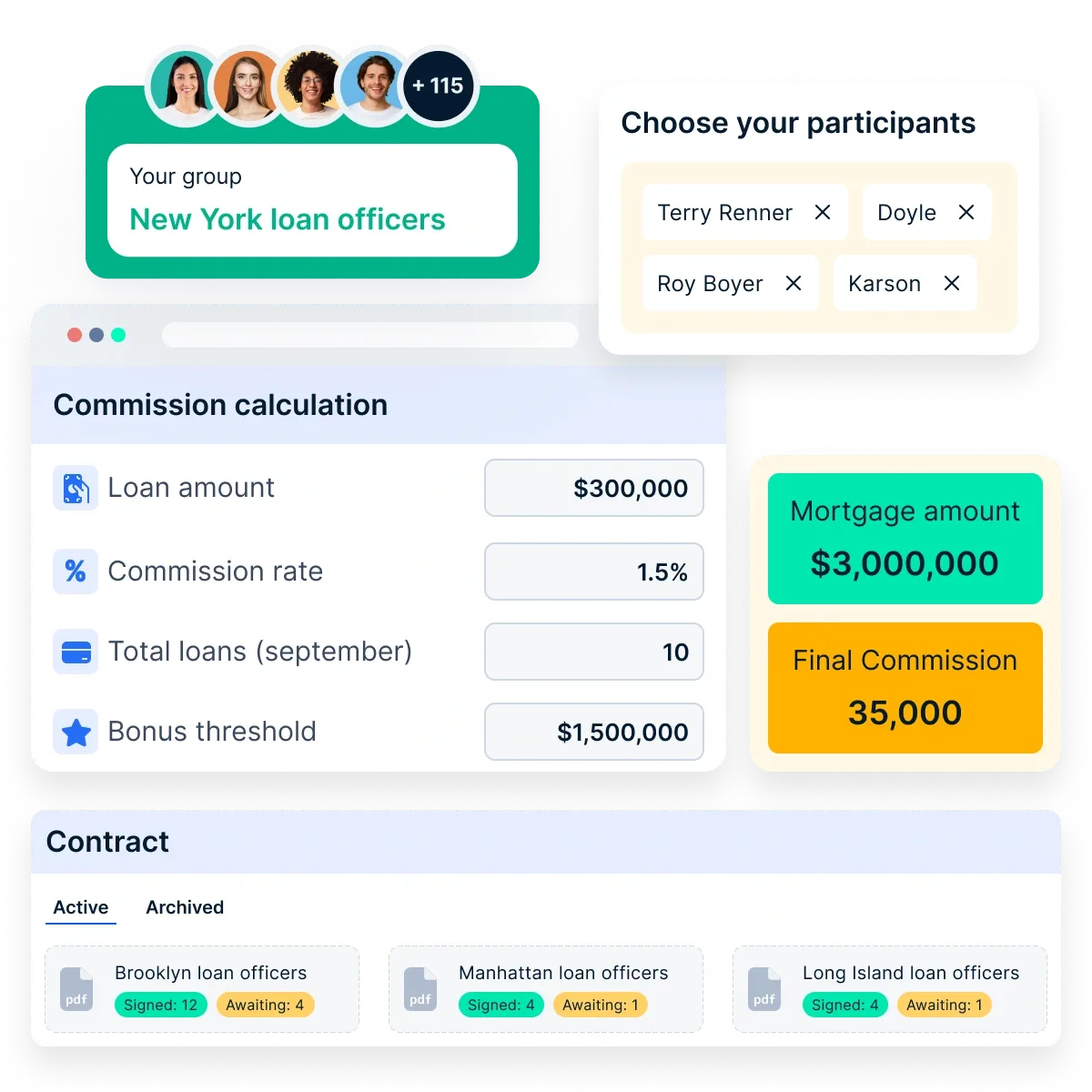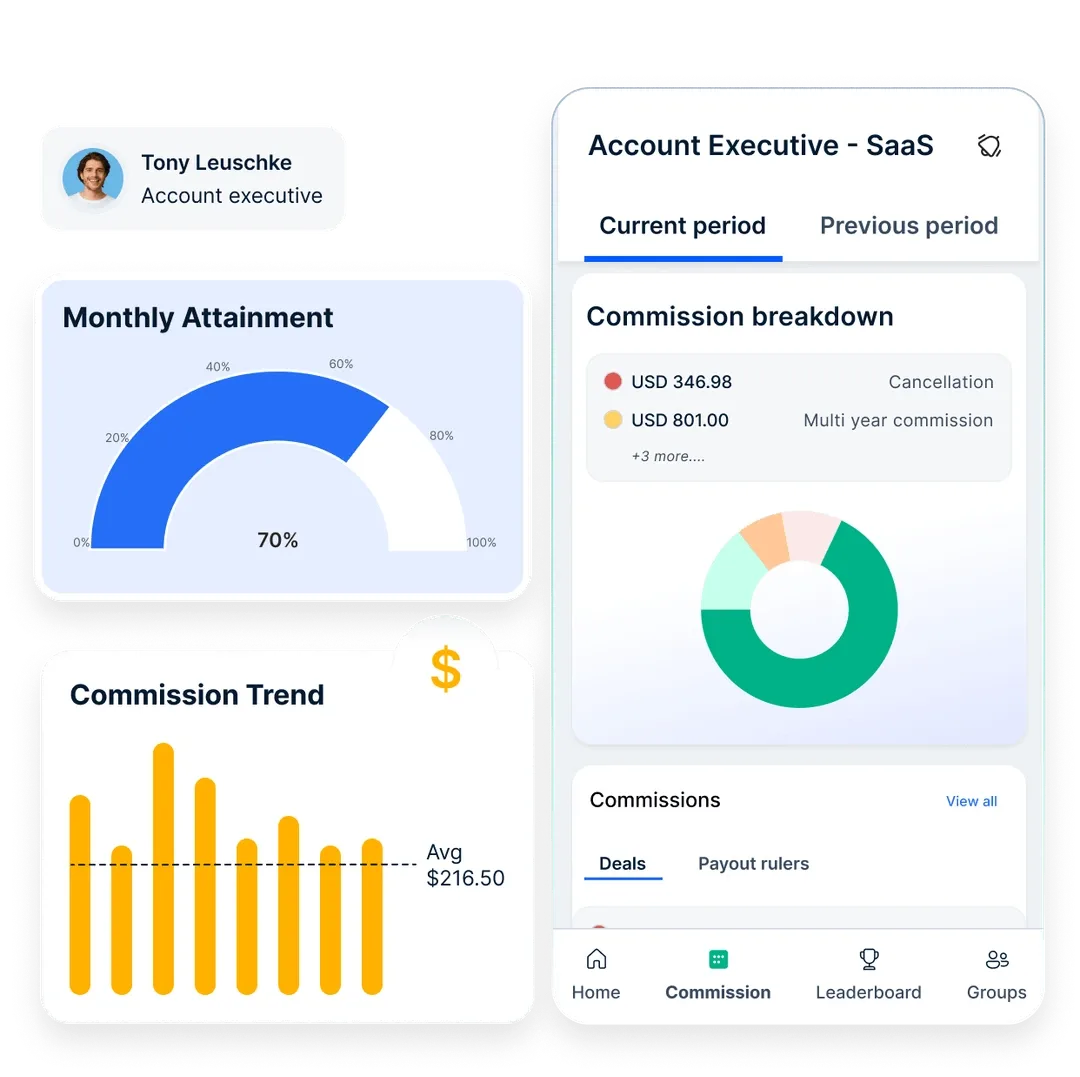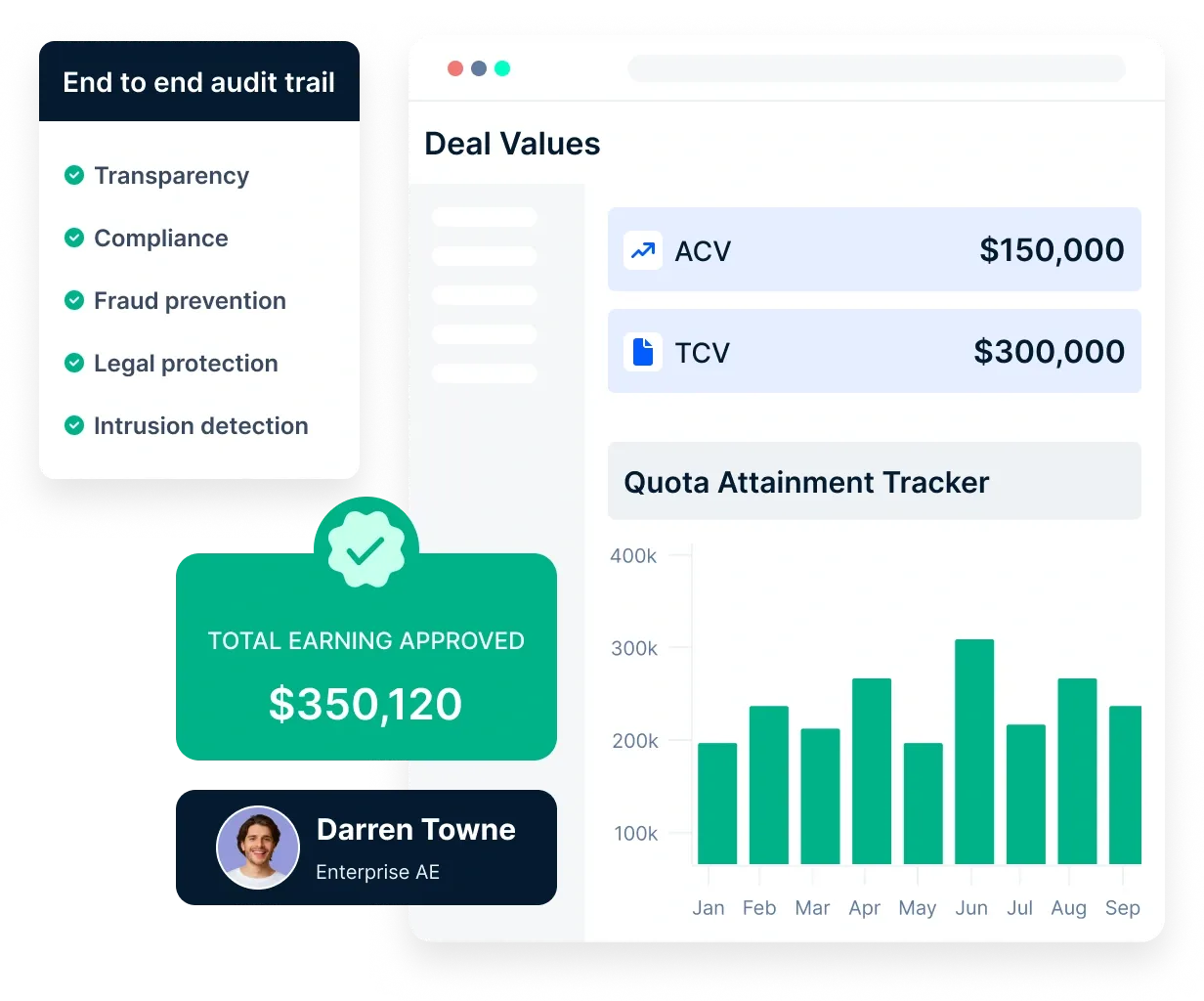مكافأة الحوافز 101: دليل التنفيذ والفوائد والمزيد
تُعد مكافأة الحوافز أداة قوية لتحفيز الموظفين وأدائهم. تعرّف على كيفية هيكلة برنامج حوافز فعال للأجور يتماشى مع أهداف العمل ويكافئ النجاح.
في هذه الصفحة
يعد التحفيز حافزًا لأداء أفضل. في المنظمة,تحفز الحوافز الموظفيننحو الأداء الفعال. تقع على عاتق فريق المبيعات مهمة كبيرة تتمثل في توليد المزيد من العملاء المحتملين. ويُعد دفع الحوافز دفعة كبيرة لهم في هذه العملية. سوف نناقش الأجور التحفيزية وكيف يمكنك تصميم برنامج أجور منتظم.
ما هو دفع الحوافز؟
الأجر التحفيزي هو المزايا الإضافية المتغيرة التي يكسبها أعضاء فريق المبيعات بصرف النظر عن رواتبهم العادية. يتم احتساب ذلك فيما يتعلق بأدائهم ومساهمتهم في أهداف العمل.
قد تكون هذه الحوافز نقدية أو غير نقدية. وقد يتم توزيعها على الجميع دون أي معايير ثابتة أو على عضو معين لتحقيق أهداف معينة. وإذا تم تنفيذها بشكل جيد، فقد تلاحظ الشركة ما يلي:
- يشعر الموظفونيشعر الموظفون بالتحفيزعندما تقدم لهم حوافز بالإضافة إلى رواتبهم العادية. فهم ينخرطون أكثر في عملهم ويساهمون بفعالية في تحقيق أهداف العمل.
- قد يأخذ الموظف غير المهتم إجازات متكررة. هذا يؤثر على الشركة ويزيد أيضا من تكلفتها. تقلل الحوافز من التغيب عن العمل من خلال تحسين معنويات الموظفين.
- يشجع الأداء العالي وخدمة العملاء الاستثنائية داخل فريق المبيعات.
- كما أنه يضع معايير للجودة داخل مندوبي المبيعات لتعزيز ثقافة الشركة الإنتاجية والتعاونية.
ولكن هناك إيجابيات وسلبيات لمكافآت الحوافز التي يجب على الشركة معرفتها لتصميم خطة مكافآت الحوافز المنظمة بشكل مناسب.
إيجابيات وسلبيات الأجر التحفيزي:
فيما يلي إيجابيات وسلبيات الأجر التحفيزي:
الإيجابيات:
يقدم أجر الحوافز العديد من المزايا. فهو يعزز إنتاجية الموظفين وتحفيزهم. تتحسن المعنويات عندما تتوافق الأهداف مع أهداف الشركة.
- تحسين إنتاجية الموظفين: تشجع المكافآت على العمل بجدية أكبر لتحقيق أهداف محددة. تحفز المكافآت التحفيزية حتى أولئك الذين لا يحققون الأهداف.
- يزيد من الاحتفاظ بالموظفين: إظهار التقدير يبني الولاء. الموظفون المقدرون يبقون لفترة أطول. وهذا يقلل من تكاليف دوران الموظفين ويعزز الاستقرار.
- تحسين المناخ التنظيمي: يحسّن الأجر التحفيزي من النظرة إلى مكان العمل. يجذب المواهب من خلال تحفيز الموظفين. تعزز الحوافز الجماعية التعاون وتكسر الحواجز.
سلبيات:
تقدم مكافأة الحوافز أيضًا بعض الجوانب السلبية. فقد يتحول التركيز من الأداء إلى المكافآت. وهذا قد يقلل من التعاون والجودة.
- يوفر فقط فائدة قصيرة الأجل: قد لا يستمر التحفيز. يمكن أن تتطور الرؤية النفقية، مما يضر بالإبداع ويزيد من التوتر.
- يؤثر على السلوك الأخلاقي للموظف: قد تحدث اختصارات غير أخلاقية لتحقيق الأهداف. قد يشعر الموظفون بالضغط للتصرف بطريقة غير شريفة للحصول على المكافآت.
- بيئة عمل غير صحية: يمكن أن تعزز المنافسة السرقة والغش. قد يشعر بعض الموظفين بالتقليل من قيمة العمل. وهذا يمكن أن يسبب التوتر والصراع.
ما هي الفروق بين الأجر التحفيزي وأجر الاستحقاق والمكافآت؟
هذه كلها طرق لمكافأة الموظفين. ومع ذلك، فإنها تعمل بشكل مختلف. مكافأة الحوافز هي لتحقيق أهداف محددة. مكافأة الجدارة تزيد الراتب الأساسي بناءً على الأداء. المكافآت هي مكافآت لمرة واحدة.
الميزة | دفع الحوافز | أجر الاستحقاق | مكافاه |
ما هو | الدفع مقابل إنجازات محددة. | زيادة الأجر الأساسي للأداء. | مكافأة لمرة واحدة. |
التردد | يختلف؛ المشروع أو على أساس الهدف. | عادةً سنويًا. | تختلف؛ يمكن أن تكون منتظمة أو غير منتظمة. |
تأثير | الأجر المتغير. | زيادة دائمة في الأجر الأساسي. | دفعة لمرة واحدة. |
استناداً إلى | أهداف محددة وقابلة للقياس. | الأداء العام. | الأداء الفردي أو أداء الشركة. |
مثال على ذلك | عمولة المبيعات. | علاوة سنوية بناءً على المراجعة. | مكافأة العطلة. |
الأجر التحفيزي: العرضي مقابل المنظم
الحوافز نوعان: الحوافز غير الرسمية والمنظمة. الحوافز غير الرسمية هي الهدايا الصغيرة. القسائم مثال على ذلك. فهي تُظهر التقدير للعمل الشاق. وهي غير منظمة.
يتم التخطيط للحوافز المنظمة. يتم رصدها. وتهدف إلى تحقيق الأهداف. ومن الأمثلة على ذلك نمو المبيعات. مكافآت نهاية العام شائعة.
الميزة | الحوافز غير الرسمية | الحوافز المهيكلة |
الطبيعة | الهدايا الصغيرة والرموز | التخطيط و رصد ومراقبة البرامج |
الغرض | إظهار التقدير | تحقيق أهداف محددة |
الجدول الزمني | غير مجدول | المقرر |
أمثلة | القسائم | مكافآت نهاية العام |
المقاييس المستهدفة | لا توجد مقاييس محددة مسبقاً | المبيعات، ورضا العملاء، وكفاءة الإنتاج، ورضا العملاء، وكفاءة الإنتاج |
17 نوعاً من أنواع الحوافز التي يمكنك تطبيقها في خطتك
يمكن أن تكون الحوافز نقدية أو غير نقدية. فيما يلي قائمة بالحوافز المقدمة للموظفين لتحسين معنوياتهم.
8 الحوافز النقدية
تسمى الحوافز ، حيث تكون المكافأة في شكل نقود ، حوافز نقدية. دعونا نلقي نظرة على بعضها.
- المكافأة:يتم إصدار مكافأة سنوية في العديد من المؤسسات. وهي لا ترتبط بالأداء ولكنها تُمنح للجميع على حد سواء. وهي علاوة على الراتب الشهري العادي الذي يتم منحه لتحفيز الموظفين.
- تقاسم الأرباح:يحصل الموظفونعلى مكافأة كنسبة مئوية من إجمالي الأرباح التي تحققها الشركة. وهذا يعتمد كلياً على الأرباح المحققة في السنة. وتعتمد هذه المكافأة السنوية على الأداء العام للشركة وليس على أي إنجاز مستهدف فردي. إذا كانت الأرباح أعلى، تزداد المكافأة أيضًا.
- مشاركة المكاسبمشاركة المكاسبلها شرط أساسي. وهنا، تتوقع الشركة من الموظفين تحقيق أهداف معينة أو تحديد معيار أداء معين. وعندما يتحقق ذلك، يحصل الموظفون على مكافأة. ولا ينبغي الخلط بين هذا الأمر ومشاركة الأرباح. حيث يتم دفع المكافآت للموظفين وفقاً لأدائهم فقط.
- الحوافز السنوية:تُدفع هذهالدفعة السنوية كنسبة مئوية من راتب الموظف. يتم دفع هذا المبلغ المقطوع عندما يصل الموظفون إلى الأهداف المحددة لهم. وقد تُدفع أو لا تُدفع في أي سنة معينة.
- المكافآت الفورية:المكافأةالفورية هي استراتيجية تسير بشكل جيد مع الموظفين. ويعد التقدير الفوري دون انتظار نهاية العام أو الانتهاء من التقييم حافزًا للموظفين. ويمكن أن تكون المكافأة نقدية أو غير نقدية. وعندما يحقق الموظف إنجازًا مميزًا، يتم الاعتراف به من خلال المكافآت الفورية.
- مكافأة المشروع:تُمنح هذه الفئة من المكافآت لمجموعة من الموظفين الذين يعملون في مشروع معين.يقوم مدير المشروعبتقييم مساهمة كل عضو من أعضاء الفريق وتحديد المكافأة عند إكمال المشروع بنجاح. يتم تحديد النسبة المئوية للمكافأة في بداية المشروع.
- المكافأة على أساس الجدارة:كما يشير الاسم، ترتبط هذه المكافأة بأداء الموظفين. يتم إجراء تقييم كل عام، حيث يقوم رئيس الفريق بتقييم مساهمة الموظف فيما يتعلق بالأهداف ويقترح مجالات للتحسين. يتم دفع نسبة مئوية ثابتة من الراتب كمكافأة، والتي قد تختلف بين موظفي نفس المشروع أيضًا.
- مكافأة الإحالة:تفضل العديد من المؤسسات تعيين الموظفين من خلال إحالات الموظفين. يتم إجراء حملة إحالة في كل مرة تنشأ فيها وظيفة شاغرة. يحصل الموظفون على مكافأة عن كل شخص يحيلونه. ويوفر التوظيف من خلال الإحالات الكثير من أموال المؤسسة وجهدها. وتعود الشركة على الموظفين في شكل مكافآت.
9 حوافز غير نقدية
المكافآت بخلاف شكل نقود هي حوافز غير نقدية.
- الإجازات مدفوعة الأجر:يُمنح الموظفونأيام إجازة للاستمتاع بإجازة ولكن مع دفع أجورهم عن تلك الأيام. يتم منح عدد محدد من الأيام كل عام كإجازات مدفوعة الأجر حتى يتمكن الموظفون من الاسترخاء والعودة إلى العمل بدافع التحفيز.
- نزهات الشركة:تنظم الشركاتنزهات سنوية للموظفين وعائلاتهم. وهذا يعني الكثير للموظفين ويرفع من معنوياتهم. ويساعد ذلك أيضاً على إقامة علاقات أفضل مع الموظفين.
- بطاقات الهدايا:تمنح بعضالشركات بطاقات هدايا بمبلغ محدد بحيث يمكن للموظفين استخدامها في التسوق. فبدلاً من شراء شيء من اختيار الشركة، يفضلون ترك الاختيار لمندوبي المبيعات.
- بطاقات العضوية:تقوم بعضالشركات بإهداء موظفيها بطاقات عضوية الصالات الرياضية أو النوادي الصحية. وهذا يدل على اهتمامهم برفاهية الموظفين. بالنسبة للموظفين الذين غالباً ما يجدون أنفسهم يتأخرون في العمل، فإن دمج المكافآت مثل بطاقات العضوية لـمجموعات الوجبات الفردية المعدة مسبقاًيمكن أن يوفر راحة مستحسنة تتجاوز الحوافز النقدية المعتادة.
- أيام العمل من المنزل:هذاحافز فريد من نوعه يلعب دوراً كبيراً في رفع الروح المعنوية للموظفين. يمكن للموظفين اختيار أيام معينة للعمل من منازلهم. تساعد هذه المرونة من جانب الشركة على تحسين إنتاجية الموظفين.
- الجوائز:يتم تقديم الجوائز للموظفين المستحقينلمساهمتهم في نمو الشركة. وهذا يحفزهم على تقديم المزيد من العطاء للشركة. يتم تنظيم فعاليات سنوية يتم فيها توزيع الجوائز على أفضل الموظفين أداءً في كل فريق.
- كوبونات الوجبات:تمنح الشركاتكوبونات يمكن استخدامها بدلاً من النقود في المطاعم. يعلق الموظفون قيمة أكبر على هذه الامتيازات بدلاً من الدفع النقدي.
- كوبونات الترفيه:الكوبوناتالتي يمكن استخدامها بدلاً من النقود في المسارح ومراكز التسوق وغيرها من المناطق الترفيهية التي تقدمها الشركات.
- برامج التدريب:تعتبر الدورات التدريبيةالتي تضيف قيمة إلى تجربة الموظف حوافز مدروسة. فهي تساعد في التقدم الوظيفي وتلقى ترحيباً من قبل الموظفين.
يمكن تقديم مثل هذه الحوافز للموظفين الانتقائيين الذين يظهرون تحسينات مثالية في الأداء. سيحفز هذا أعضاء الفريق الآخرين أيضا على بذل المزيد من الجهد ليكونوا مؤهلين لمثل هذه الدورات التدريبية.
A شركة كبيرة لتصنيع ماكينات CNC في آسيا كانت تنمو بسرعة. وقد زادت الشركة من التشغيل الآلي لماكيناتها. كان لدى الشركة أكثر من 32 موقعًا للمبيعات والخدمات في جميع أنحاء العالم. كانوا بحاجة إلى منصة قوية لأتمتة العمولات. أرادوا منح مندوبي المبيعات إمكانية الوصول إلى بيانات الحوافز. كما أرادوا أيضاً تقليل الوقت الذي يستغرقه حساب الحوافز. وكان الهدف الرئيسي هو تقليل حاجة مديري المبيعات إلى التعامل مع العمولات يدوياً.
الحل:
استخدمت الشركة حل إدارة عمولات المبيعات من Compass. قامت Compass بتبسيط عملية العمولة. واستخدم محرك حساب العمولة والأتمتة. وقد أعطى ذلك شفافية. واستخدمت أيضاً نظاماً أساسياً للتلعيب لجعل البيع ممتعاً. كان الأداء مرئياً. زادت Compass من دقة حسابات الحوافز. قلل من الوقت اللازم لمعالجة عمولات المبيعات. وقد تحقق ذلك من خلال ميزات مثل سير عمل البرنامج ومحرك القواعد1. كما تم استخدام الموافقات ولوحات المتصدرين وبطاقات الأداء وتطبيق الهاتف المحمول1. سمح تطبيق الهاتف المحمول للأفراد بمشاهدة أدائهم في الوقت الفعلي.
النتائج:
اكتسبت الشركة رؤية في الوقت الفعلي لحسابات الحوافز باستخدام Compass. كما تمكنوا أيضًا من مراقبة دقة المدفوعات. تم إشراك فريق المبيعات من خلال الاختبارات والشارات والنقاط، مما أدى إلى تحسين اعتماد برنامج الحوافز. كما قامت الشركة أيضًا بأتمتة عملية العمولة من البداية إلى النهاية. وقد أزال ذلك حاجة قادة المبيعات إلى التعامل معها يدويًا.
التأثير:
- شهدت الشركة زيادة بنسبة 20% في تحقيق الحصص في أقل من 90 يومًا.
- زادت مؤهلات برنامج الحوافز بنسبة 22%.
- زاد اعتماد المنصة بنسبة 73%.
كيف يتم احتساب الأجر التحفيزي؟
يختلف أجر الحوافز. ويعتمد ذلك على الشركة والدور. توجد طرق شائعة. بعضها يعتمد على الأداء الفردي. ويستخدم البعض الآخر أهداف الفريق. كما يمكن أن تدخل أرباح الشركة في الحسبان. عادة ما يكون الحساب قائمًا على الصيغة. وهذا يضمن الشفافية. يعرف الموظفون كيفية كسب المزيد.
الأجر التحفيزي = (الأداء الفردي / الأداء المستهدف) * مبلغ الحافز
كيفية إنشاء برنامج حوافز الأجور التحفيزية؟
تتبع كل منظمة خطوات لإنشاء برنامج حوافز لموظفيها. يمكن أن تساعدك الخطوات التالية في إنشاء برنامج حوافز.
1. التخطيط
كل تنفيذ ناجح يبدأ بخطة. يحتاج برنامج حوافز المنظمة أيضا إلى التخطيط السليم لتحديد أنواع الحوافز ووقت الدفع ومعايير اختيار الموظف. يساعد التخطيط المنظمة على إصلاح الميزانية لنفسه.
يجب أيضا إبلاغ فريق المبيعات بالخطة لتمكينهم من المساهمة بفعالية. يلعب الدور الذي يلعبه الأعضاء الأفراد والموقف في الفريق أيضا دورا في تحديد نوع الحافز. يجب أن يكون تخطيط الحوافز مرنا حيث قد تنشأ العديد من التغييرات في بيئة الأعمال.
كيف يمكن Compass المساعدة؟

Compass يساعد الشركات على تخطيط الحوافز بسهولة. فهو يسمح لهم بنمذجة خطط التعويضات المختلفة ومعرفة تأثيرها قبل وضع اللمسات الأخيرة. يمكن للشركات اختبار سيناريوهات مختلفة للعثور على أفضل ما يناسب فرقها.
ويمكنهم أيضاً تحليل الخطط السابقة لمعرفة الخطط التي نجحت بشكل أفضل واستخدامها كنموذج. إذا تغيرت اتجاهات السوق أو أهداف الشركة، فإن Compass تجعل من السهل تعديل خطط الحوافز في أي وقت.
2. المراقبة
المراقبة المستمرة ضرورية للحفاظ على البرنامج وتشغيله. تساعد مراقبة الخطة القادة على مقارنتها بالأداء. يجب على المؤسسة تحديد ما إذا كان فريق المبيعات يفهم الخطة. يجب أن يراقبوا أدائهم لمساعدتهم على تلبية معايير الحوافز المطلوبة.
المراقبة تجلب الانتباه إلى أي هفوات في الخطة بحيث يمكنك تصحيحها على الفور. يحتاج التنفيذ الناجح للخطة إلى دعم جميع أعضاء الفريق ، وتساعد المراقبة في تحقيق ذلك.
كيف يمكن لـ Compass المساعدة في مراقبة الخطة؟

Compass يساعد في المراقبة من خلال تقديم تقارير مفصلة عن تحقيق الحصص وأداء المنطقة وفعالية الخطة. وهو يتتبع تقدم مندوبي المبيعات على تطبيق الهاتف المحمول، مما يمنح المديرين والمديرين وفرق المراجعة رؤية واضحة للأداء.
يمكن لفرق الشؤون المالية تحليل تأثير الإيرادات على العمولات باستخدام تقارير مخصصة لتخطيط الميزانية بشكل أفضل. من خلال هذه الرؤى، يمكن للقادة تحديد الثغرات بسرعة، وإجراء التصحيحات، وضمان بقاء خطة الحوافز فعالة.
3. التقييم
التقييم هو أيضا جزء من إنشاء برنامج الحوافز. بعض المنظمات لديها مراجعات نصف سنوية وتقدم حوافز. يمكن إجراء التقييم بعد هذه الفترة لتحديد ما إذا كان البرنامج مثاليا.
يساعد في تحليل أداء الفريق فيما يتعلق بالخطة.
بعض الأسئلة التي يجب عليك طرحها في هذه الخطوة هي:
- هل كان البرنامج ممكنا؟
- هل سمحت بحرية كافية للموظفين للعمل على الأهداف؟
إذا كانت نتائج التقييم تشير إلى أن برنامج الحوافز يسير بسلاسة ، فيمكن الاستمرار في ذلك. إذا لم يكن الأمر كذلك ، فيجب إجراء تغييرات لجعل برنامج الحوافز مناسبا للموظفين والأعمال.
كيف يمكن Compass المساعدة في التقييم؟

تساعد Compass المؤسسات على تقييم برامج الحوافز الخاصة بها من خلال توفير تقارير متقدمة، وتتبع نفقات العمولة، والتحليلات التنبؤية، ومسارات التدقيق. من خلال تقارير العمولة السنوية والرؤى الخاصة بالمناطق، تكتسب الشركات رؤية واضحة حول كيفية مساهمة العمولات في الإيرادات.
يضمن إعداد تقارير مالية دقيقة تخطيطاً وتحليلاً أفضل، بينما تمكّن التحليلات التنبؤية فرق الشؤون المالية من تقييم تأثير الإيرادات على العمولات من أجل تخصيصات الميزانية المستقبلية.
بالإضافة إلى ذلك، تُنشئ ميزة سجل التدقيق تقارير مفصلة عن التغييرات التي تطرأ على خطط عمولات المبيعات والتعديلات وسجل المدفوعات، مما يضمن الشفافية والامتثال. تساعد هذه الرؤى المؤسسات على تحديد مدى فعالية برامج الحوافز الخاصة بها وإجراء التعديلات اللازمة لتحقيق توافق أفضل مع أهداف العمل.
4. التحسين
تساعد مرحلة التقييم في تحديد أفضل برنامج للمنظمة. الحوافز ليست دفعة لمرة واحدة. إنها عملية مستمرة وقد تتطلب مراجعات بشكل متكرر.
قد تصبح معايير الأداء قديمة حسب الظروف. يجب أن تصل الشركة إلى برنامج خطة مثالي حتى يكون عرضا مجزيا للموظفين.
يجب على عملك تحديد وسد الثغرات في النظام إن وجدت. تحسين برنامج الحوافز يساعد في هذه العملية.
من المهم أيضا معرفة كيفية إنشاء برنامج دفع جيد. النصائح المذكورة أدناه يمكن أن تساعد!
في المخص:
دفع الحوافز هو محفز ويحفز فريق المبيعات على المساهمة بفعالية. إنها واحدة من أفضل الطرق لتقريب الموظفين من أهداف العمل. يجب أن يتضمن برنامج الحوافز النقاط المذكورة أعلاه ليكون فعالا.
برنامج الحوافز الجيد مفيد للمنظمة وكذلك للموظفين. إذا لم تكن قد خططت لك بعد ، فتذكر النقاط المذكورة أعلاه لتنفيذ خطة جيدة التنظيم.
الأسئلة الشائعة
1. هل الأجر التحفيزي بالساعة؟
لا، الأجر التحفيزي بشكل عام ليس بالساعة. وعادةً ما تكون مرتبطة بأهداف أداء محددة.
2. ما هو الأجر التحفيزي؟
أجر الحوافز هو تعويض مصمم لتحفيز الموظفين على تحقيق أهداف محددة وتحسين الأداء.
3. هل الأجر التحفيزي هو علاوة؟
لا، الأجر التحفيزي ليس علاوة. العلاوة هي زيادة في الراتب الأساسي. الأجر التحفيزي متغير ويعتمد على الأداء.
4. ماذا تقصد بالأجور التحفيزية؟
الأجور التحفيزية هي الأرباح التي تعتمد على تجاوز معيار محدد للإنتاج أو المبيعات، مما يحفز الموظفين على أن يكونوا أكثر إنتاجية.
5. هل يستحق الأجر التحفيزي ذلك؟
نعم، يمكن أن تستحق الحوافز الأجر. تشير الدراسات إلى أن خطط الحوافز المحسّنة يمكن أن تعزز المبيعات بشكل كبير وتحسّن من تحفيز الموظفين.
6. لماذا تقدم المنظمات أجورًا تحفيزية؟
تقدم المؤسسات مكافآت تحفيزية لدفع نمو الإيرادات، وتحفيز موظفي المبيعات، ومواءمة سلوك الموظفين مع أهداف الشركة، وتحسين الأداء العام.
ما الذي يعتبر أجرًا تحفيزيًا؟ يشمل الأجر التحفيزي المكافآت والعمولات ومشاركة الأرباح والأجر القائم على الأداء والمكافآت الأخرى المرتبطة بتحقيق أهداف محددة.
هل الشركات مطالبة بتقديم حوافز تشجيعية؟ لا، لا يُطلب من الشركات عمومًا تقديم حوافز تشجيعية. عادةً ما يكون ذلك وفقًا لتقدير صاحب العمل، على الرغم من أن عقود العمل قد تنص على خلاف ذلك.














